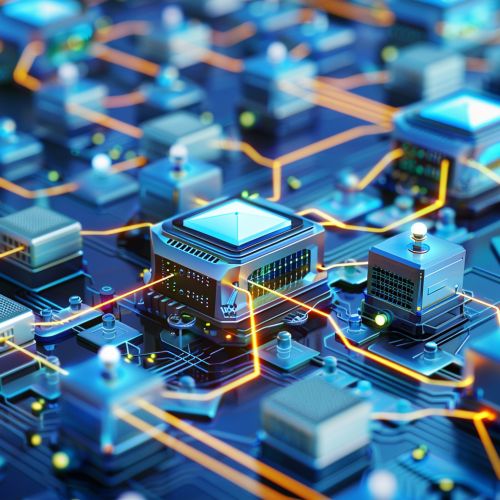Distributed Computing
Overview
Distributed computing is a model in which components of a software system are shared among multiple computers to improve efficiency and performance. It is a field of computer science that studies distributed systems. A distributed system is a system whose components are located on different networked computers, which communicate and coordinate their actions by passing messages to each other.
History
The concept of distributed computing originated in the early 1970s with the advent of computer networks. The need to share resources and communicate efficiently led to the development of protocols and algorithms that could handle the complexities of a distributed environment. The first distributed systems were primarily used for military and scientific applications, but with the rise of the Internet in the 1990s, distributed computing became more mainstream.
Principles
Distributed computing operates on several key principles. The first is concurrency of components, which allows multiple tasks to be executed simultaneously, improving system performance. The second is lack of a global clock, meaning that individual components operate independently without a central timing source. The third is independent failure of components, which ensures that the failure of one component does not affect the overall system.
Types of Distributed Systems
There are several types of distributed systems, including cluster computing, grid computing, and cloud computing.
Cluster Computing
Cluster computing involves a group of linked computers, working together closely so that in many respects they form a single computer. The components of a cluster are commonly, but not always, connected to each other through fast local area networks.
Grid Computing
Grid computing is a form of distributed computing whereby a 'super and virtual computer' is composed of a cluster of networked, loosely coupled computers, acting in concert to perform very large tasks.
Cloud Computing
Cloud computing is a type of computing that relies on shared computing resources rather than having local servers or personal devices to handle applications. In cloud computing, the word cloud (also phrased as "the cloud") is used as a metaphor for "the Internet," so the phrase cloud computing means "a type of Internet-based computing," where different services — such as servers, storage and applications — are delivered to an organization's computers and devices through the Internet.
Distributed Computing Models
There are several models of distributed computing, including the client-server model, the peer-to-peer model, and the hybrid model.
Client-Server Model
In the client-server model, one or more computers act as servers, and other computers act as clients. The servers provide resources or services, and the clients request them.
Peer-to-Peer Model
In the peer-to-peer model, all computers act as both servers and clients. This model is often used in file sharing systems.
Hybrid Model
The hybrid model combines elements of both the client-server and peer-to-peer models. It is often used in large, complex systems.
Distributed Algorithms
Distributed algorithms are algorithms designed to run on distributed systems. These algorithms must take into account the fact that system components are spread across multiple computers and communicate via message passing. Examples of distributed algorithms include the Paxos consensus algorithm and the Raft consensus algorithm.
Distributed Computing and Big Data
Distributed computing plays a crucial role in big data processing. Frameworks like Apache Hadoop and Apache Spark allow for distributed processing of large data sets across clusters of computers. These frameworks are designed to handle failures at the application layer, so delivering a highly-available service on top of a cluster of computers, each of which may be prone to failures.
Challenges in Distributed Computing
Distributed computing presents several challenges, including communication latency, data consistency, and fault tolerance.
Communication Latency
In a distributed system, computers must communicate with each other to coordinate their actions. This communication can introduce latency into the system, especially if the computers are geographically dispersed.
Data Consistency
Maintaining data consistency in a distributed system can be challenging. If multiple computers are updating the same data, mechanisms must be in place to ensure that all computers have a consistent view of the data.
Fault Tolerance
Fault tolerance is the ability of a system to continue operating properly in the event of the failure of some of its components. In a distributed system, if one computer fails, the system must be able to continue operating.
Future of Distributed Computing
The future of distributed computing is likely to be shaped by advances in cloud computing, the Internet of Things (IoT), and edge computing. These technologies will require more sophisticated distributed systems and algorithms to handle the increasing volume and complexity of data.
See Also
- Parallel computing
- Concurrency
- Distributed database
- Distributed file system
- Distributed hash table
- Distributed memory
- Distributed operating system


